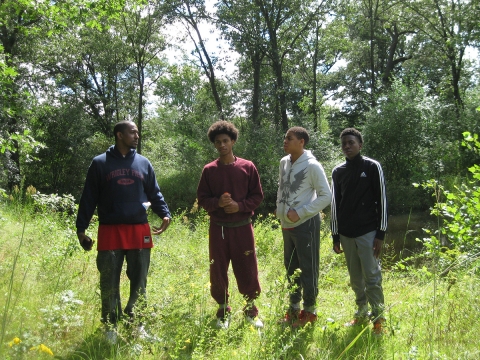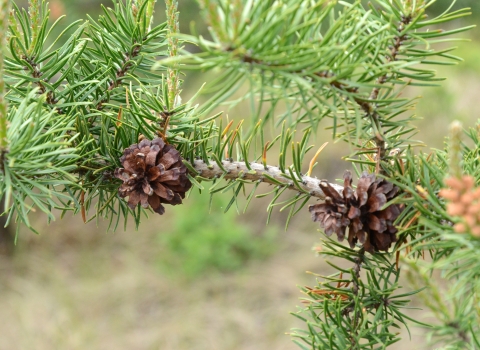One aspect of a land ethic is time. Time spent blooming season after season, generation after generation in one place, can foster a connection with the land, or as Aldo Leopold once called it, a land ethic. We at the U.S. Fish and Wildlife Service want to shine a light on one family who planted themselves in the sand prairies and black oak savannas of central Illinois and share a little about why they love this special place. Please take a moment to learn how the Spraggins family is growing their generational connection to nature.
Born in Chicago, Illinois, in 1984, Ronald Spraggins, official steward of the family property, reflects on how his childhood memories intertwined with his family's land. "My fondest childhood until present-day memories are how we would escape the hustle and bustle of the city and gather on any area of the 41 acres we own in Pembroke Township.”
As he sees it, nature is a teacher. “It gives me not only a sense of inner peace but educates me about all the things that are a part of nature: soil, sunlight, water, insects, plants, animals, all that was here before us, and hopefully, after us," he reflects.
Ronald acknowledges the importance of having protected species on his family's land. “They are essential simply because they were thought to be extinct. We also have endangered species, and anything in danger of never being seen again is something to be shared.”
Named by his mother and uncle as the official steward of the family property, Ronald sees the importance of protecting native plants and other species that make their land home, like ornate box turtles, regal fritillary butterflies and the yellow wild indigo plant. With all their land in its natural state, the Spraggins family hopes to steward and protect these areas for future generations while providing ecotourism opportunities in support of their local community.
Another Spraggins family connection to their land is the joy they share when gathering there. It’s a place for recharging, relaxing and releasing, as Ronald describes it. They meet on their land for family reunions, camping, horseback riding and simply for the comfort of each other's company. Their land is essential for reconnecting with each other and ensuring that all is well with everyone.
You might be asking yourself how private land relates to a national wildlife refuge national wildlife refuge
A national wildlife refuge is typically a contiguous area of land and water managed by the U.S. Fish and Wildlife Service for the conservation and, where appropriate, restoration of fish, wildlife and plant resources and their habitats for the benefit of present and future generations of Americans.
Learn more about national wildlife refuge managed by the federal government. As Refuge Manager Cassie Skaggs sees it, conservation-focused private lands like these are a beautiful complement to the work that she is shepherding at the refuge. In the late summer of 2022, Cassie started a position as the new refuge manager for Kankakee National Wildlife Refuge and Conservation Area. She knew that this area of the world had been drawing people from all over because of the incredible biological diversity. She has learned since then that this geography is so much more than plants and animals. It’s about people.
The Kankakee River Basin is known as a premier area for wildlife. Like the Spraggins family, people settled here and have been engaging in conservation practices because of it. While birders and other ecotourists flock to the area to see rare red-headed woodpeckers capturing insects in flight and are a welcome boost to the economy, the local community members themselves have had the most significant impact. Because of the wildlife and habitat work of local and private landowners, past and present, folks like Cassie and Ronald can work together on the shared goal.
While biologically impressive, the local community is equally rich in culture and importance, which is why this special place still exists today. This cultural treasure is steeped in a sense of well-being that folks feel when they’re out in nature. This feeling may be the soul of their land ethic. In the words of Ronald's mother, Michelle Spraggins, “Some of us don't know why we seem to be more at ease, yes, even at peace, whether it be in a backyard, a park or any open land area. One thing is for sure: we know we enjoy the feeling. While no specific thing is evident as to why we are drawn to nature or land, the conclusion in hindsight is that we are connected.”
“Each family member I’ve met has maintained a humbleness and desire to support the local community through maintaining their land ownership with thought to ecodevelopment that preserves the natural assets of the area,” notes Cassie.
In the year that she’s been in her new role as refuge manager, Cassie’s come to learn that this ownership is more than a just a deed on paper. “It’s a legacy of guardians who have stewarded this land to present day with the hope that the plants, wildlife, peace and tranquility of Pembroke will be present for future generations,” continues Cassie.
We aim to foster this feeling on and around this young national wildlife refuge. Established in 2016, Kankakee National Wildlife Refuge and Conservation Area is relatively new and reasonably small, comprising 66 acres of upland oak savanna. Regardless of age or size, it is founded on this recreation tradition and is open for everyone to enjoy.
Learn more about Kankakee National Wildlife Refuge and Conservation Area




